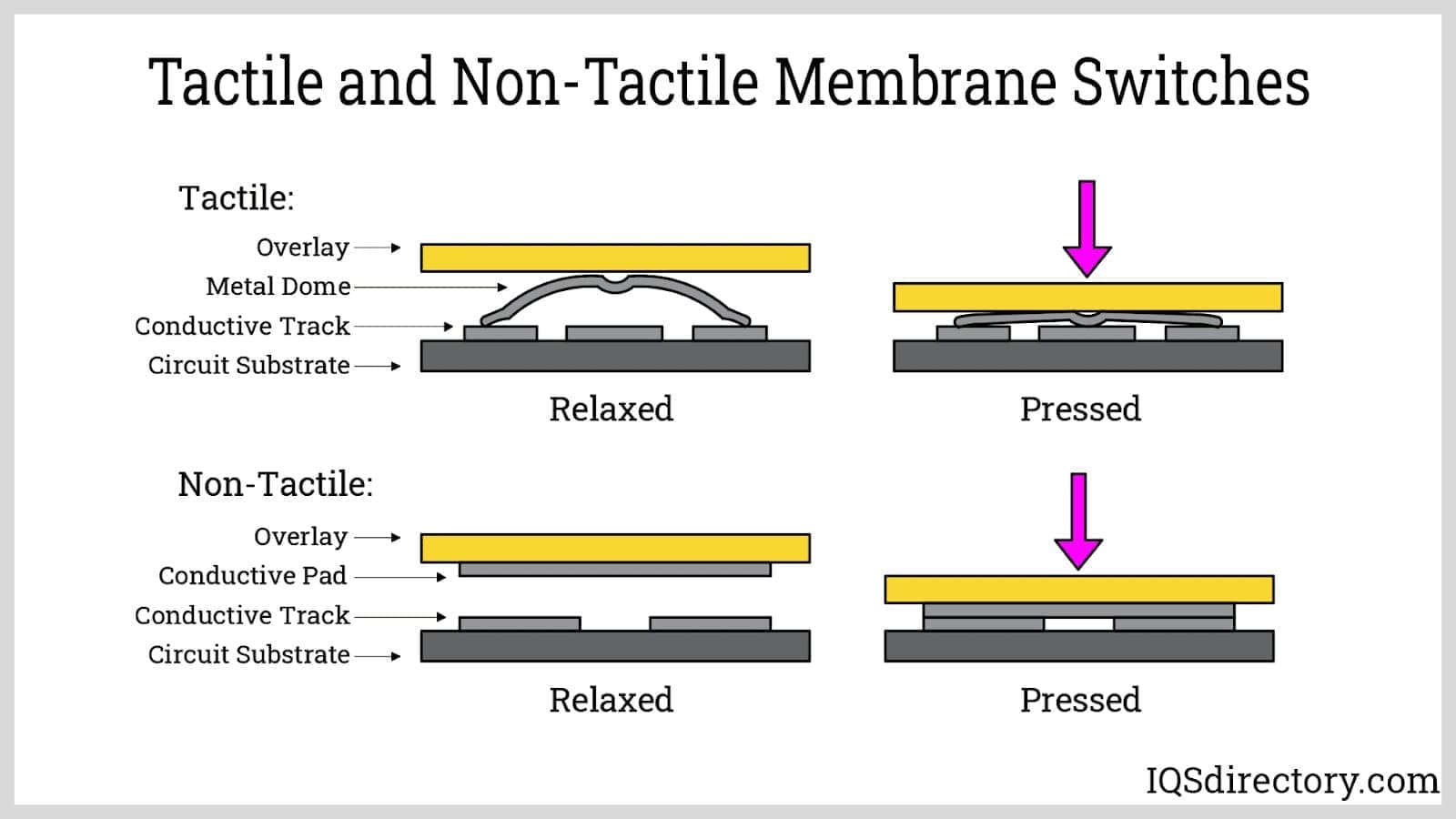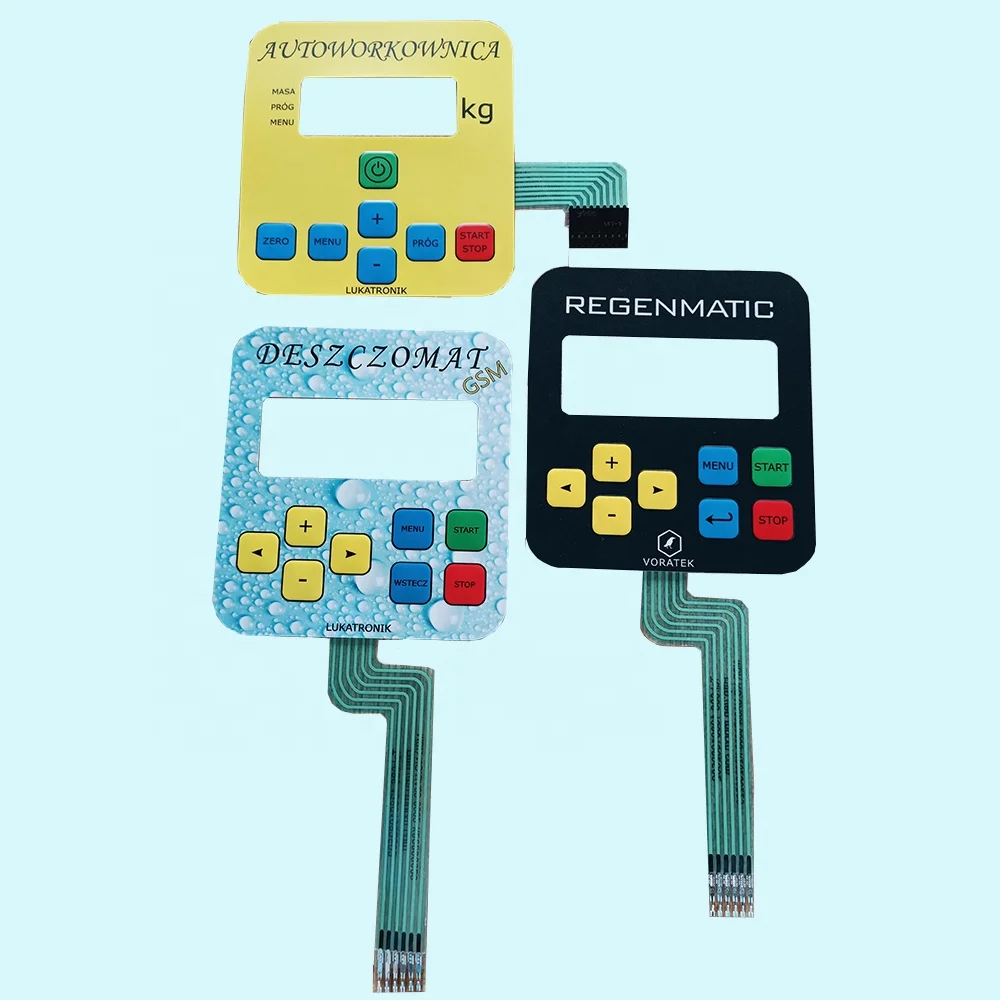Membrane Switch Manufacturer Delivering Highly Personalized Solutions
Membrane Switch Manufacturer Delivering Highly Personalized Solutions
Blog Article
Exactly How Membrane Switch Innovation Functions and Its Function in User User Interface Design
Membrane switch technology is an advanced technique that combines layered materials for touch-sensitive input. When pushed, its design is composed of graphic overlays, conductive layers, and adhesive parts that interact. This interaction not only completes an electric circuit however additionally affects the total individual experience. Recognizing the complexities of this technology reveals its substantial effect on user interface layout, prompting inquiries regarding its applications and future growths in numerous markets.
Understanding Membrane Switch Technology
Membrane switch technology works as a crucial element in contemporary customer interface style. This technology combines graphic overlays, touch-sensitive membrane layers, and circuit layers to produce a portable, trusted input technique for numerous tools. The style typically consists of multiple layers, including a printed visuals layer that enables users to interact with the gadget through responsive responses. Membrane buttons are recognized for their durability, resistance to dampness, and simplicity of cleansing, making them appropriate for atmospheres where traditional mechanical buttons might fail. Their low-profile design enables smooth integration right into gadgets, adding to a streamlined look. In enhancement, Membrane switches can be personalized with numerous colors, textures, and icons, improving individual experience and visual allure. This adaptability makes them prominent in customer electronics, clinical devices, and commercial controls, where intuitive interaction is crucial. Generally, Membrane switch technology represents a substantial improvement in how customers involve with electronic user interfaces.
Secret Elements of Membrane Switches
Membrane switches contain a number of essential parts that add to their functionality and style. The conductive layer products, glue and assistance layers, and visuals overlay layout each play an important role in making sure suitable performance and user interaction. Recognizing these components is necessary for reliable interface design.
Conductive Layer Materials
Conductive layer products play a necessary function in the performance and reliability of Membrane buttons. These materials are liable for completing electric circuits when stress is used to the button. Normally, a combination of conductive inks, such as silver or carbon, is made use of to produce these layers. Silver conductive ink is preferred for its premium conductivity and durability, while carbon ink is commonly made use of for economical applications. The selection of product impacts not only the electrical performance however additionally the total lifespan of the button. Furthermore, the density and make-up of conductive layers can affect responsive feedback and button actuation. Selecting the suitable conductive product is essential for making certain suitable efficiency in diverse individual interface applications.
Sticky and Assistance Layers
Sticky and assistance layers are essential components that add to the architectural integrity and functionality of Membrane switches. These layers provide a durable structure, guaranteeing that the various elements of the Membrane switch continue to be firmly bonded and effectively lined up throughout their functional life. The adhesive layer assists in the accessory of the button to the underlying surface, offering sturdiness against ecological elements such as wetness, temperature variations, and mechanical tension. Assistance layers boost the switch's rigidity, protecting against contortion during use and contributing to a regular tactile response. With each other, these elements play an important function in maintaining the performance and durability of Membrane buttons, eventually affecting the general user experience in user interface design.
Graphic Overlay Layout
Although often ignored, graphic overlay layout plays a crucial duty in the functionality and appearances of Membrane switches. This design largely functions as the user interface in between the user and the electronic devices, supplying both visual charm and functional clarity. Effective visuals overlays utilize color, typography, and icons to lead individuals in comprehending and navigating controls tool functions. The option of products impacts longevity and responsive feedback, making certain the overlay endures wear while keeping an enjoyable user experience. In addition, precise alignment of the overlay with the underlying components is vital for ideal efficiency. Finally, thoughtful visuals overlay layout boosts usability, adds to brand name identification, and eventually influences individual complete satisfaction in tools using Membrane button modern technology.
The Production Process of Membrane Switches Over
The manufacturing procedure of Membrane switches entails numerous critical steps that ensure functionality and durability. At first, a graphic overlay is created, including individual interface elements and branding. This overlay is published onto a flexible substratum, normally polyester or polycarbonate, making use of accuracy printing strategies to identify quality and color accuracy.Next, adhesive layers are used, complied with by the assimilation of conductive traces, usually made from silver or carbon, which are crucial for electrical connection. These traces are screen-printed or etched onto a separate layer. After this, a spacer layer is contributed to develop the required gap in between the circuit and the overlay layer, permitting responsive feedback when activated.Finally, the parts are constructed and checked for quality control, guaranteeing that each Membrane switch meets the needed requirements for performance and integrity. This careful process leads to a robust product matched for numerous applications in interface layout.
Benefits of Utilizing Membrane Switches Over

Membrane changes offer many advantages that make them a preferred selection in interface layout. One substantial benefit is their lightweight and portable nature, enabling for streamlined designs in numerous applications. Additionally, Membrane switches provide a secured interface, shielding against dirt, dampness, and impurities, which improves longevity and dependability. They are additionally highly adjustable, allowing designers to produce special graphics and layouts customized to details user needs.Another advantage is their cost-effectiveness, as they typically require less product and labor compared to traditional buttons. The tactile comments of Membrane buttons can be crafted to improve user experience, using an enjoyable response without the mass of mechanical parts. Membrane switches can be easily incorporated into varied environments, such as medical devices, commercial devices, and consumer electronics. On the whole, these benefits emphasize the growing popularity of Membrane switches in modern interface style.
Applications in Various Industries
Widely made use of throughout numerous industries, Membrane button modern technology has actually discovered its location in applications varying from medical gadgets to customer electronics. In the medical care industry, these switches are indispensable to tools such as diagnostic devices and client surveillance systems, using durable, easy-to-clean interfaces that withstand sanitation processes. The automotive sector utilizes Membrane switches in dashboards and control panels, giving reputable operation in challenging environments.Consumer electronic devices, including home appliances and gaming consoles, benefit from the smooth design and customizability of Membrane buttons, boosting customer interaction. Additionally, commercial equipment utilizes these switches for control board, ensuring resistance to dust and dampness while preserving functionality.Moreover, the aerospace and military industries utilize Membrane buttons for sturdy applications, where dependability and performance are important. In general, Membrane button modern technology serves diverse industries by integrating capability, longevity, and aesthetic allure, making it a functional option for contemporary interface.

Designing Interface With Membrane Switches Over
When creating customer interfaces with Membrane switches, cautious consideration of both capability and visual appeal is important. Membrane switches over use a smooth, low-profile design that can enhance aesthetic charm while preserving usability. Developers should concentrate on switch design, guaranteeing user-friendly placement for ease of procedure. The why not try here responsive responses given by the Membrane button is vital; it can influence customer complete satisfaction and total experience.Additionally, color and visuals elements must straighten with the brand identification, enhancing acknowledgment and experience. Selecting long lasting materials that withstand damage is additionally important, as longevity adds to use gradually. Incorporating backlighting can improve visibility in different lights conditions, further improving user communication. Inevitably, a well-designed Membrane button user interface equilibriums both form and function, making sure that the customer experience is both interesting and effective, fulfilling the demands of diverse applications throughout sectors.
Future Patterns in Membrane Switch Modern Technology
As Membrane switch innovation evolves, the integration of smart performances is coming to be increasingly popular. These innovations allow improved interactivity and connectivity within interface (membrane switch manufacturer). Furthermore, the change towards green products reflects a growing commitment to sustainability in layout practices
Smart Membrane Changes

Eco-Friendly Products Use
Amidst the developments in Membrane button technology, a significant pattern is arising in the direction of the usage of environment-friendly products. Producers are increasingly focusing on sustainability by including safe inks and naturally degradable plastics, decreasing environmental influence. This shift not just lines up with worldwide environmental criteria yet also addresses customer demand for greener items. Developments in material scientific research have actually made it possible for the development of sturdy, eco-friendly alternatives that preserve efficiency without endangering quality. These materials use similar functionality to standard alternatives while lessening waste and toxicity. As industries become extra eco-conscious, the assimilation of sustainable practices in Membrane switch manufacturing is expected to increase, reinforcing a commitment to environmental obligation and paving the means for more lasting individual interface remedies in the future.
Regularly Asked Concerns
How Do Membrane Switches Over Differ From Standard Mechanical Switches?
Membrane changes differ from typical mechanical switches largely in construction and procedure. They make use of versatile layers that produce a secured find more information interface, whereas mechanical switches count on physical motion and get in touch with, leading to distinctive durability and responsive responses attributes.
Can Membrane Changes Be Custom-made for Particular Applications?
Membrane buttons can indeed be personalized for specific applications - membrane switch manufacturer. Makers design them to satisfy distinct needs, permitting tailored designs, graphics, and performances that boost individual communication and fit particular operational requirements successfully
What Is the Life expectancy of a Membrane Switch?
The life-span of a membrane switch generally varies from 1 to 5 million actuations, depending upon aspects such as material quality, environmental conditions, and usage regularity. Regular testing can assist establish its durability and dependability in applications.
Are Membrane Switches Resistant or water-proof to Chemicals?
Membrane buttons can be designed to be waterproof and resistant to chemicals, relying on the materials utilized and making processes. Proper securing and safety finishes improve their longevity in numerous environmental conditions and applications.
Exactly How Do Membrane Switches Effect Gadget Energy Consumption?
Membrane buttons can greatly impact gadget energy intake by ensuring reliable procedure. Their low power requirements throughout activation assistance decrease power use, adding to longer battery life and total improved effectiveness in digital tools. Membrane switches are recognized for their sturdiness, resistance to moisture, and convenience of cleansing, making them suitable for atmospheres where typical mechanical buttons might stop working. The automotive industry utilizes Membrane buttons in control panels and control panels, giving reliable operation in difficult environments.Consumer electronic devices, including home appliances and pc gaming consoles, advantage from the smooth layout and customizability of Membrane buttons, improving individual communication. Additionally, industrial machinery uses these switches for control panels, guaranteeing resistance to dust and wetness while maintaining functionality.Moreover, the aerospace and army fields make use of Membrane buttons for rugged applications, where integrity and performance are vital. The advancement of Membrane button technology is going into an amazing stage with the development of clever Membrane buttons, which incorporate innovative functions and functionalities. Membrane switches over vary from traditional mechanical buttons mainly in building and operation.
Report this page